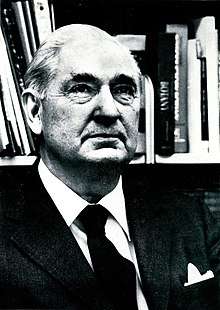William C. Steere
| William C. Steere | |
|---|---|
 |
"Bill Steere" redirects here. For the Irish priest, see William Steere.
William Campbell Steere (1907–1989) was an American botanist known as an expert on bryophytes (mosses, liverworts, and hornworts), especially arctic and tropical American species.[1][2] He earned his PhD from the University of Michigan in 1932, then taught botany there for 21 years, eventually becoming chairman of the botany department. He then spent eight years at Stanford University as professor and dean of the Graduate Division, before joining the New York Botanical Garden as director and then president.[3][4]
He is commemorated in the names of the plant genera Steereocolea, Steerea, Steereobryon, and Steerella. Additionally Mount Steere in Antarctica is named for him.[1] In 1970, he was the last recipient of the Mary Soper Pope Memorial Award in botany.[5] The standard author abbreviation Steere is used to indicate this person as the author when citing a botanical name.[6]
References
- 1 2 Stafleu, Frans Antonie; Cowan, Richard S. (1985). Taxonomic Literature: A Selective Guide to Botanical Publications and Collections with Dates, Commentaries and Types. 5. pp. 863–864.
- ↑ Brassard, Guy R. (1989). "In Memoriam: William C. Steere, 1907-1989". Arctic and Alpine Research. 21 (4): 435. JSTOR 1551654.
- ↑ Crum, Howard (1977). "William Campbell Steere: an account of his life and work". The Bryologist. 80 (4): 662–694. doi:10.2307/3242430.
- ↑ Buck, William (1986). "William Campbell Steere: An Outline of His Life and Continuing Career". In Hecht, Max. Evolutionary Biology. 20. New York: Springer. pp. 1–24. ISBN 978-1-4615-6985-5.
- ↑ "Cranbrook Institute of Science Director's Papers". Cranbrook website. Retrieved Dec. 27, 2016.
- ↑ IPNI. Steere.
External links